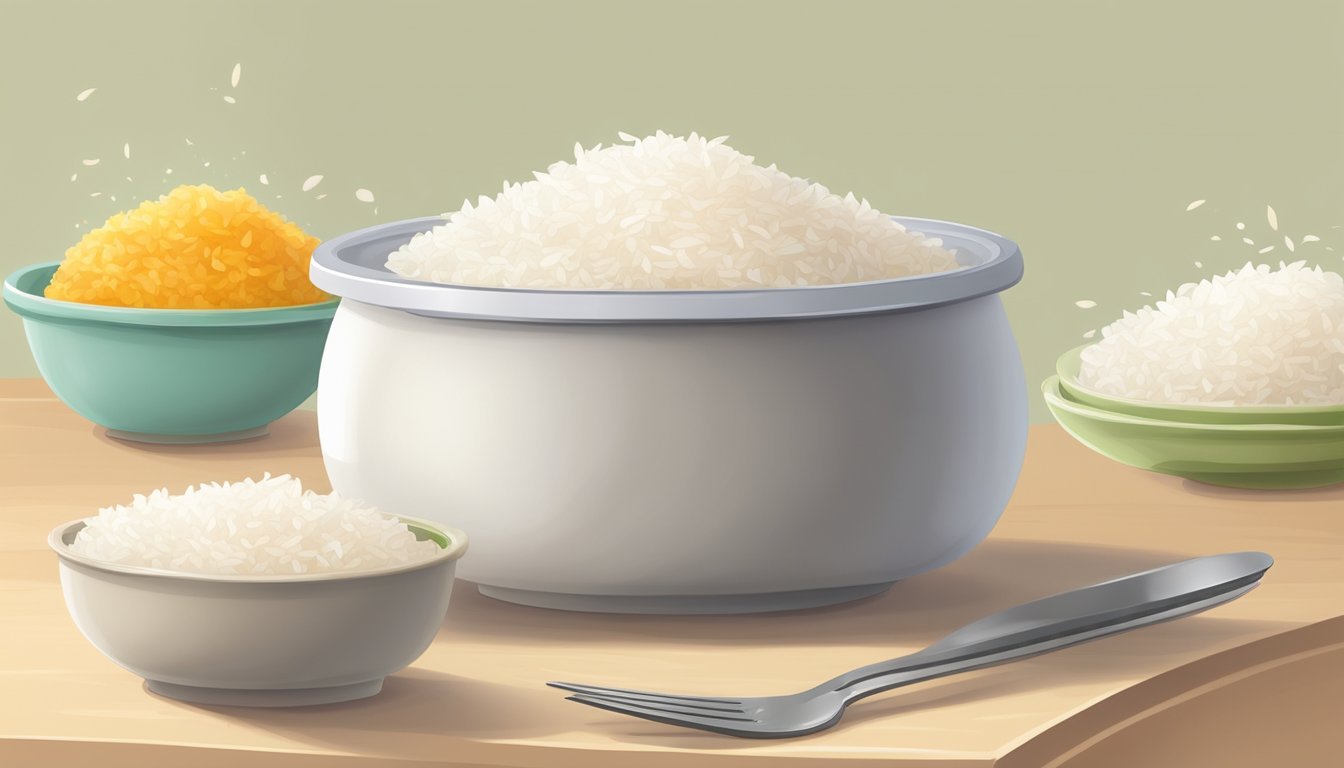How to Reheat Coconut Rice
Best Techniques for Perfect Flavors
Coconut rice, with its fragrant aroma and rich flavor, can be an absolute delight even as leftovers. To reheat coconut rice effectively, using the microwave is a quick method. Place the rice in a microwave-safe bowl, add a splash of water, cover with a damp paper towel, and heat in 30-second intervals until warm.
For those who prefer the stove, there's a simple way to bring back the coconut rice's freshness. Add the rice to a saucepan with a little water, cover with a tight-fitting lid, and warm it over low heat, stirring occasionally to break up any clumps.
Alternatively, the oven can also be used for reheating. Place the rice in an oven-safe dish, sprinkle with some water, and cover the dish tightly with foil. Heat at a low temperature until the rice is evenly warmed. Each method ensures that the rice retains its moisture and taste, making your coconut rice just as delightful as when it was first cooked.
Importance of Proper Reheating
Proper reheating of coconut rice is essential for both safety and taste. Bacteria, especially Bacillus cereus, can grow quickly at room temperature, leading to food poisoning. Ensuring that coconut rice is reheated to the right temperature helps eliminate these risks.
Often, rice sits out for some time before being stored. This period allows bacteria to thrive, making correct reheating crucial. Consistently heating rice to at least 165°F (74°C) is recommended.
Maintaining the delicate flavor and texture of coconut rice also requires proper technique. Adding a small amount of water or broth can prevent dryness. Covering the dish securely keeps moisture locked in, ensuring a pleasant dining experience.
People often overlook the importance of evenly spreading rice and stirring occasionally. This ensures that all grains are heated uniformly, reducing the risk of cold spots where bacteria might survive.
Using the oven, microwave, or stovetop, each method has its merits. The key is reaching the safe reheating temperature while retaining the rice's quality. Frequent checking and stirring can make a significant difference.
In summary, taking the time to reheat coconut rice properly is not just about enjoying it but also about staying safe from potential health risks. A few simple steps can make all the difference.
Preparing Coconut Rice for Reheating
Proper handling and storage are crucial for reheating coconut rice effectively without sacrificing texture or flavor. Key aspects include how the rice is stored and how moisture is retained or reintroduced during reheating.
Storing Leftover Rice
Store leftover coconut rice in an airtight container to maintain its freshness. This minimizes the risk of the rice absorbing unwanted odors from the refrigerator.
Rice should be cooled to room temperature within two hours after cooking to prevent foodborne illness. Once cool, transfer the rice to the container and place it in the refrigerator.
For longer storage, freeze the rice. Divide it into portions and place each in a freezer-safe bag or container. Label with the date to manage storage time effectively. Thaw frozen rice in the refrigerator overnight before reheating.
Rice Hydration Techniques
Moisture is key when reheating coconut rice to ensure it remains fluffy and aromatic. Add a small amount of water or coconut milk to the rice before reheating. About 1-2 tablespoons per cup of rice will suffice.
Cover the rice with a damp paper towel or foil to trap the steam. This prevents the rice from drying out during the reheating process.
For stovetop reheating, place the rice in a saucepan, cover, and reheat on low heat. Stir occasionally to distribute moisture evenly.
When using a microwave, cover the rice with a damp paper towel and heat in short intervals, stirring in between to ensure uniform moisture distribution.
Reheating Coconut Rice on the Stovetop
Reheating coconut rice on the stovetop ensures it retains its aromatic flavors and fluffy texture. This method is straightforward and involves key steps like using a saucepan and adding the right amount of moisture.
Using a Saucepan
Start by choosing a suitable saucepan. It should be large enough to hold the amount of coconut rice you are reheating without crowding. This allows the rice to heat evenly.
Place the rice in the saucepan. It's important to spread it out evenly to avoid clumping and promote even heating.
Set the stove to low heat. This gentle heat prevents the rice from drying out or burning.
Add a tablespoon of oil or butter before the rice begins to heat. This step not only adds moisture but also enhances the flavor. Coconut oil works well to complement the coconut flavor of the rice.
Stirring and Adding Moisture
To keep the rice fluffy and prevent it from drying out, add a splash of water before reheating. Use about two tablespoons of water per cup of rice. This creates steam, which helps to rehydrate the rice grains.
Cover the saucepan with a lid, leaving a small gap for steam to escape. Stir the rice occasionally to ensure even heating and to prevent it from sticking to the bottom of the pan.
If necessary, add additional spices or seasoning during this stirring process to revive the flavors. Keep stirring until the rice is thoroughly heated, which usually takes about 5-7 minutes.
This method effectively brings back the texture and flavor of your coconut rice, making it enjoyable as if freshly cooked.
Microwaving Coconut Rice
To reheat coconut rice in a microwave effectively, adjusting the power level and using a damp paper towel for covering are key steps. This ensures the rice retains its moisture and reheats evenly.
Setting the Correct Power Level
Reheating coconut rice on high power can make it dry and unevenly heated. Instead, set the microwave to medium power (50-70%). This gentler setting reduces the risk of drying out the rice and ensures even reheating.
Microwave the rice for 1-2 minutes per cup. After the initial minute, check the rice. If it needs more time, microwave in 30-second increments to avoid overcooking. Stir the rice halfway through the reheating process to distribute the heat evenly.
Covering Rice with a Damp Towel
Moisture retention is crucial when reheating coconut rice. Place the rice in a microwave-safe dish, then cover it with a damp paper towel. The damp towel traps steam, helping the rice stay moist.
Plastic wrap is an alternative to a damp towel. Make a few small holes in the wrap to allow steam to escape. This prevents the rice from becoming too soggy while still keeping it moist.
Using this technique, the rice should come out fluffy and aromatic, similar to when it was first cooked.
Using the Oven to Reheat
Reheating coconut rice in the oven ensures even warming while retaining its moisture and flavor. Follow these steps for the best results.
Preheating the Oven
Begin by preheating the oven to 350°F (180°C). Maintaining a consistent temperature allows the rice to heat evenly without drying out.
An accurate temperature is vital. It prevents the coconut rice from becoming too dry or overcooked. While the oven preheats, ensure that the rice is spread evenly on a baking sheet to facilitate uniform warming.
Covering Rice with Foil
Place the coconut rice on an oven-safe dish or baking sheet. Add a small amount of water or broth to maintain moisture during reheating.
Cover the dish tightly with aluminum foil. This step is crucial as it seals in the moisture, preventing the rice from becoming dry. Bake the covered dish for about 15-20 minutes.
Periodic stirring might be necessary to ensure that the rice heats throughout without any cold spots. Checking halfway through can help maintain quality and texture.
Alternate Reheating Methods
When reheating coconut rice, there are several alternate methods to preserve its fluffy texture and moisture. Using a slow cooker can keep the rice warm without drying it out, and creating a rice pilaf transforms leftovers into a flavorful dish.
Using a Slow Cooker
Using a slow cooker to reheat coconut rice ensures even heating while retaining moisture. First, add a small amount of water or broth to the rice to avoid dryness. Place the rice in the slow cooker and set it to a low heat setting. Cover the cooker with its lid to trap steam inside.
To maintain the rice's fluffy texture, stir occasionally to distribute the heat evenly. This method is convenient for those who prefer a hands-off approach. Additionally, the gentle heat from the slow cooker helps prevent the rice from becoming overcooked or burnt.
Creating a Rice Pilaf
Transforming coconut rice into a rice pilaf can add a new dimension to leftover rice. Start by heating a bit of oil or butter in a skillet. Add chopped onions, garlic, or other desired aromatics and sauté until fragrant. Then, add the coconut rice to the skillet.
Stir the rice to combine it with the aromatics, and add a small amount of broth if needed to enhance moisture. Cover the skillet with a lid and let it cook on low heat until the rice warms through. This method not only reheats the rice but also infuses it with additional flavors, making the meal more enjoyable.
Using these methods, coconut rice can be reheated effectively, keeping it moist and flavorful.
Finishing Touches
Enhancing reheated coconut rice can significantly improve its flavor and texture. Focusing on seasoning and adding ingredients can transform simple leftover rice into a delightful side dish.
Adjusting Seasoning and Consistency
When reheating coconut rice, it's important to check the seasoning and consistency. Start by tasting the rice. Salt and pepper might be needed, depending on the initial recipe.
Add Moisture: If the rice seems dry, stir in a bit of full-fat coconut milk or a pat of butter. This will help restore its creamy texture.
Lime Juice: A squeeze of fresh lime juice can enhance the flavors, adding a touch of acidity that pairs well with the coconut.
Soy Sauce: Light soy sauce can be used sparingly to add a bit of umami and saltiness.
By focusing on these adjustments, the reheated coconut rice can regain its original flavor and creaminess.
Incorporating Additional Ingredients
Incorporating simple ingredients can elevate the rice even more. Consider these options:
Fresh Herbs: Chopped cilantro or parsley can add color and freshness.
Vegetables: Lightly stir-fry vegetables like peas, carrots, or bell peppers before mixing them into the rice.
Protein: Add cooked proteins such as shrimp, chicken, or tofu to turn it into a more substantial meal.
Nuts and Seeds: Toasted sesame seeds or chopped nuts can add a delightful crunch.
These additions can customize the coconut rice to fit a variety of meals, making it a versatile and enjoyable side dish.





